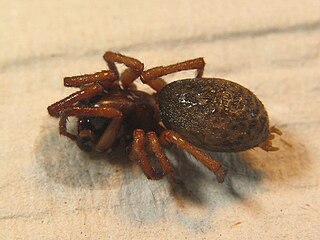
Jumping spiders are a group of spiders that constitute the family Salticidae. As of 2019, this family contained over 600 described genera and over 6,000 described species, making it the largest family of spiders – comprising 13% of spider species. Jumping spiders have some of the best vision among arthropods and use it in courtship, hunting, and navigation. Although they normally move unobtrusively and fairly slowly, most species are capable of very agile jumps, notably when hunting, but sometimes in response to sudden threats or crossing long gaps. Both their book lungs and tracheal system are well-developed, and they use both systems. Jumping spiders are generally recognized by their eye pattern. All jumping spiders have four pairs of eyes, with the anterior median pair being particularly large.

Huntsman spiders, members of the family Sparassidae, catch their prey by hunting rather than in webs. They are also called giant crab spiders because of their size and appearance. Larger species sometimes are referred to as wood spiders, because of their preference for woody places. In southern Africa the genus Palystes are known as rain spiders or lizard-eating spiders. Commonly, they are confused with baboon spiders from the Mygalomorphae infraorder, which are not closely related.

The Araneomorphae are an infraorder of spiders. They are distinguishable by chelicerae (fangs) that point diagonally forward and cross in a pinching action, in contrast to the Mygalomorphae, where they point straight down. Araneomorphs comprise the vast majority of living spiders.

Tarantulas comprise a group of large and often hairy spiders of the family Theraphosidae. As of December 2023, 1,100 species have been identified, with 166 genera. The term "tarantula" is usually used to describe members of the family Theraphosidae, although many other members of the same infraorder (Mygalomorphae) are commonly referred to as "tarantulas" or "false tarantulas". Some of the more common species have become popular in the exotic pet trade. Many New World species kept as pets have setae known as urticating hairs that can cause irritation to the skin, and in extreme cases, cause damage to the eyes.

Spiders are air-breathing arthropods that have eight limbs, chelicerae with fangs generally able to inject venom, and spinnerets that extrude silk. They are the largest order of arachnids and rank seventh in total species diversity among all orders of organisms. Spiders are found worldwide on every continent except Antarctica, and have become established in nearly every land habitat. As of September 2024, 52,309 spider species in 134 families have been recorded by taxonomists. However, there has been debate among scientists about how families should be classified, with over 20 different classifications proposed since 1900.

Inermocoelotes is a genus of funnel weavers first described by S. V. Ovtchinnikov in 1999.
Inermocoelotes anoplus is a funnel-web spider genus found in Austria, Italy and Eastern Europe.
Inermocoelotes brevispinus is a spider species in the family Agelenidae, found in Bulgaria.
Inermocoelotes deltshevi is a funnel-web spider species found in North Macedonia and Bulgaria.
Inermocoelotes drenskii is a funnel-web spider species found in Bulgaria.
Inermocoelotes falciger is a funnel-web spider species found in Eastern Europe.
Inermocoelotes gasperinii is a funnel-web spider species found in Croatia.
Inermocoelotes halanensis is a funnel-web spider species found in Croatia.

Inermocoelotes inermis is a species of funnel-web spider that was first described by Ludwig Carl Christian Koch in 1855.
Inermocoelotes jurinitschi is a funnel-web spider species found in Bulgaria.
Inermocoelotes kulczynskii is a funnel-web spider species found in Bulgaria.
Inermocoelotes microlepidus is a funnel-web spider species found in Italy, Bulgaria and Macedonia.
Inermocoelotes paramicrolepidus is a funnel-web spider species found in Greece.
Inermocoelotes xinpingwangi is a funnel-web spider species found in Bulgaria.





